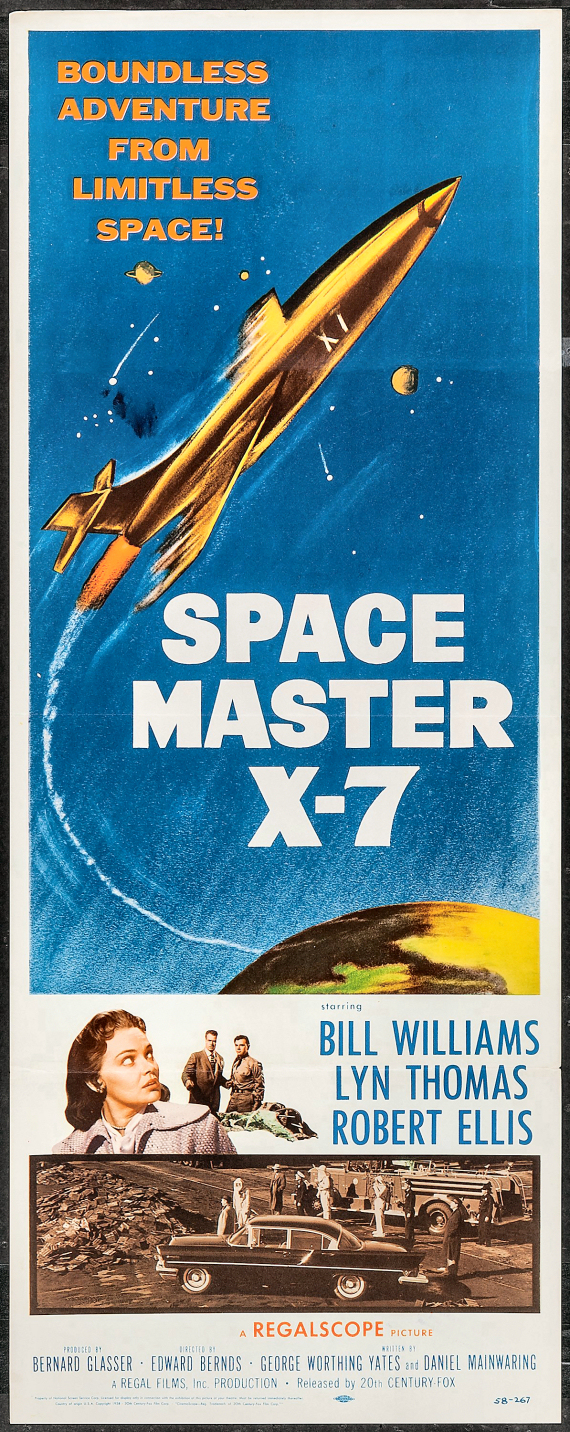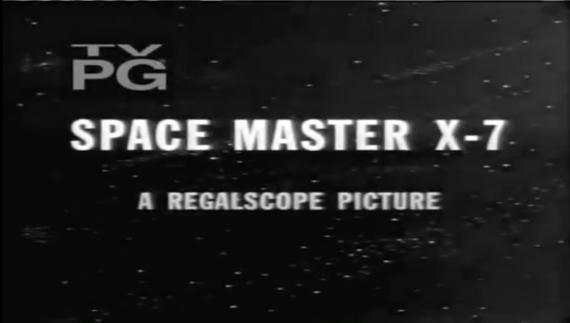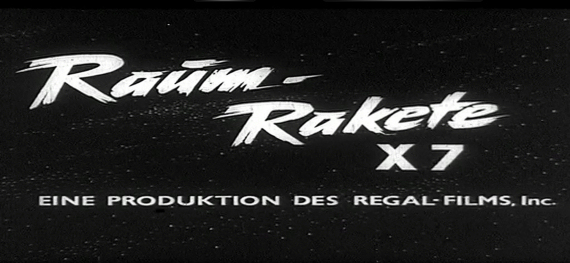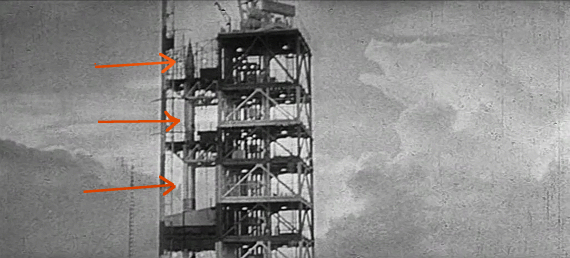
For the past several days, we (I and my wife, the Beautiful & Talented Lynne Taylor Fahnestalk) have been looking for old black-and-white SF movies (well, mostly any SF/F genre film that’s over 50 years old), and have been having some success in the late 1950s era. I was in particular looking for British B/W SF films on the order of Quatermass; I remember watching one in the ‘60s on KSTW-TV (Channel 11, Tacoma) when I was in high school, but I wasn’t able to find it again in later year. (I actually have seen it again fairly recently; it’s from 1958, called The Strange World of Planet X or, in the US, The Cosmic Monster.)
1958 was a banner year for both good and bad genre films, ranging from the War of the Colossal Beast (not so hot SF) or The Crawling Eye (bad SF) to The Fly (classsic SF) and 7th Voyage of Sinbad (classic fantasy); there are too many genre films from 1958 to detail here, but I’m sure you can Google (or DuckDuckGo, my favourite non-tracking search engine—unsolicited plug) it yourself.

Today’s “middlin’-good” SF film is also from that year, and it’s called Space Master X-7 (Figure 2a) (or, Raum-Raket X7—which means Space Rocket X7—in German, Figure 2b), depending on where you find it. It’s obviously a TV screen cap on the Internet Archive; the YouTube version has been pulled, saying that Fox had claimed copyright on it.

The Internet Archive version is a fairly fuzzy standard definition; we were lucky to find the much clearer German one somewhere after a search (can’t refind it, so no link. Sometimes the movies I find on teh interwebz are one-time finds).

Pay attention, now. You’ll notice that Figure 3 is titled “Satellite ‘Spacemaster XM-712’”; I’ve highlighted the rocket bearing the satellite, which is the titular/eponymous “Space Master” of the film. This is one of approximately two places in the movie the satellite is mentioned. I find that to be very weird, as are both the beginning and ending of this film. I’ll explain more as we go along.
The cast contains several people who will look vaguely familiar; a couple of them have been minor characters/character actors in a number of motion pictures and TV shows of the era. The main actors, Bill Williams (“John Hand”), Lyn Thomas (“Laura Greeling”), and Robert Ellis (“Pvt. Joe Ratigan”) have among them several hundred TV & movie credits, but not one of them ever hit the “big time.” But one or two will actually be familiar: the actor who plays the scientist that sets off the major action in the film (Dr. Pommer) is Paul Frees who, whether you know his name or not, you’ve seen or heard in lots of stuff if you’ve been a TV or movie watcher from the ‘fifties to the (approximately) ‘80s. The other you will probably recognize; he plays a taxi driver in this film and, though he’s not onscreen very long, will jog your memory. I refer to Moe Howard, who was, more or less, the leader of The Three Stooges.
Except for those two, you probably won’t know any of the other actors (leads or not) except as “Oh, yeah—I’ve seen him [or her] before; it’s that guy [or gal].”
The movie purports to be a warning so that you, the viewer, will know “what to do to survive.” (I’m not going to shy away from spoilers; after all, the movie’s more than half a century old already.) It begins with a narrator at a desk (with the U.S. Capitol Building seen from his window behind) telling you that this film has been made to tell you the truth so you can survive. The U.S. Government (along with the government of Sov-yet Russia) has been sending rockets into outer space and XM-712 was sent a thousand miles above the Earth some months ago. It carried recording devices, cameras, the usual non-human passengers (shows a monkey being prepared for space), and Dr. Pommer’s experiment to find out whether there’s actually life outside the Earth.
It’s the first rocket that’s been designed to return safely to Earth so that we can determine what conditions are like in “outer space”; and the return to California is triggered as we watch. The rocket lands and all the stuff is brought back, including the box containing Dr. Pommer’s experiment. He’s a gruff, no-nonsense scientist who’s been given permission to finalize his experiment in his home lab; he’s driven there by Pvt. Ratigan, and carrying his experiment. He is met there by Mrs. Greeling, with whom, we find, he has had a boy child, although she is now married to a man in Honolulu who has no idea that she’s had a child. Pommer tells her the child is in a boarding school; his home/lab is no place for a boy. She wants the child, and throughout the next half-hour as Pommer works on his experiment, recording his thoughts on a reel-to-reel tape, she bursts into the lab—which is set off from the rest of the house by a glass door—interrupting him and angering him. She says she loves her husband and will tell him some story about adopting the boy; Pommer is obviously still smitten with her, though she tells him “the torch is out.”
Pommer tapes his work with the spores that returned with the rocket; these spores he calls “blood rust,” because of the colour (blood red—kind of ironic in a b/w movie, not to mention that Mars isn’t exactly that colour), and because it’s the reason—according to him—that Mars is red! The fungus seasonally takes over the whole planet. Apparently even one spore is enough for it to take a foothold and consume anything and everything edible—and it shoots spores all the time. He’s a bit careless, however, and he leaves the blood rust container open a lot.
While Pommer works on his experiment Mrs. Greely becomes more impatient; she wants custody of their son. We learn that Dr. Pommer has written a letter giving her custody; there’s a struggle and she whacks him with something from his desk. She’s called a cab, and as he lies nearly unconscious, she leaves, giving the cabbie (Moe Howard) $20 to forget he ever picked her up. (She thinks maybe she killed Dr. Pommer.) She didn’t, but when he gets up and goes back into the lab, he is attacked by the fungus, which has spread all over the lab. Meanwhile, the people (National Security Agency of some kind) who sponsored the experiment have grown impatient and, not knowing of Mrs. Greeling’s existence, are coming out to the house. They’ve been alerted by a phone call by a dying Dr. Pommer, who tells them to burn his house and lab, “every stick.” Mr. Hand (Bill Williams) and Pvt. Ratigan (Robert Ellis) find him being consumed by the fungus; Ratigan gets a stick and gets the tape from the recorder, which is almost covered with fungus. Taking gas cans from their jeep, they burn the house.
Back at the base, they and the tape are given strict decontamination; the jeep is destroyed—they’re taking no chances with this fungus which could destroy every living thing on the Earth. They hear Mrs. Greeling’s voice on the tape and realize she could be a spore carrier. Thus begins the hunt for her. Tracking down the cab, they make an Identi-Kit® picture of her from the cabbie’s description and circulate it. The cabbie’s disinfected; his cab is destroyed. By now the doctor’s death in a fire has been printed in the paper and, seeing it, Mrs. Greeling thinks she killed him. When the picture of her, an unknown woman, is published everywhere—TV and newspapers—by the authorities, she thinks they’re after her for killing him. She narrowly escapes detection a couple of times and finally rents a hotel room, sending out for different clothes and some makeup and hair colouring (she was a blonde; she becomes a brunette). Her handbag, full of spores, infects the hotel room after she leaves.
Ratigan finally traces her, not knowing exactly who she is or what she looks like, follows her onto a plane for Honolulu, knowing that she’s now a brunette and planning to interview all the brunettes on board the plane. (It sounds funny in today’s world that an airplane will take about 8 hours to fly to Honolulu, but propellor-driven planes are very slow compared to today’s jets.) Ratigan must find her before the plane can no longer return to California, a matter of a few hours. (It’s what pilots call the “bingo” point, where they must return to base or they won’t have enough fuel to do so.)
Eventually, she learns why Ratigan’s trying to find her and confesses who she is; they discover that her luggage in the luggage compartment has grown a lovely bunch of fungus. The plane turns back, but not before the fungus escapes the baggage compartment and starts covering the windows from outside the plane.
Eventually the plane lands on its belly and all the people are herded onto buses for decontamination—and the film abruptly ends! That was weird; Lynne says “I guess they ran out of money.” One would think they’d wrap things up, but… who knows?
So the film isn’t really about the Space Master at all. The viewer is left wondering: were they able to decontaminate all the passengers? While the fungus was covering the outside of the plane, did the fungus shoot spores all over the Pacific Ocean? Did they destroy the plane? Hmph.
I wanted to mention Paul Frees (“Dr. Pommer”) a bit more; you may not be familiar with him or his career. Paul was, as well as an actor, a voice actor for TV and movies, and an impressionist (I have an LP in my collection where he does impressions of various Hollywood persons like Humphrey Bogart.) You may have heard his voice in dozens of cartoon features like Rocky and Bullwinkle, where he supplied the voice of Boris Badanov. He worked for Disney (Professor Ludwig Von Drake, for one), Jay Ward (Badanov, as above), Rankin-Bass (he was Elrond and Bombur in The Return of the King) and many others. According to Wikipedia, he supplied Bogart’s voice in Bogey’s last film, as Bogey’s cancer had advanced to the point where he wasn’t properly audible. The link above will take you to Wiki’s article on Frees.
In the coming months I intend to cover a bunch more old movies; in many of them you can see the ways their prop departments tried to make things more “science-fictiony”; today we have computers, LEDs, and all sorts of CGI to make almost anything the script can come up with. In those days they needed to be more creative, and there was less emphasis on the “special effects.” (I’m especially fond of Japanese miniature-making; some of the models are incredibly detailed.) 1956-1959 are great years for classic (and terrible) genre movies.
If you want to tell me you enjoyed or hated this column, you can comment here or on Facebook, or even by email (stevefah at hotmail dot com). All comments are welcome! (Just be polite, please.) My opinion is, as always, my own, and doesn’t necessarily reflect the views of Amazing Stories or its owner, editor, publisher or other columnists. See you next time!











This film has special meaning for me. When I was seven my thirteen-year-old brother took me to see the war movie “The Enemy Below” starring Robert Mitchum. As we were walking up the aisle after the film was over, we paused to watch a trailer for “Space Master X-7.” It looked fantastic! A blob monster! What more could a little kid want?
Alas, my brother didn’t take me to see it. For years I vividly remembered scenes from the trailer, but not the title. I confidently expected it would show up on TV, but it never did.
Forty years later I still hadn’t seen this movie. I consulted reference books and couldn’t find any plot resembling what I remembered. Drove me nuts whenever I thought about it. How could a film disappear so completely?
Being only an hour and 11 minutes long, it wasn’t suitable for most movie time slots on TV. Consequently, it seldom aired.
Finally, my good friend Stan G. Hyde gave me a VHS copy and I discovered that “Space Master X-7” was indeed the “lost” film from my childhood. I was happy the mystery had been solved before I died. For this reason, I remain fond of the film for sentimental reasons.
Plus, it’s cop show documentary style appeals to me. So to speak, a science fiction episode of “Dragnet.” I quite love this little film, low budget and all.